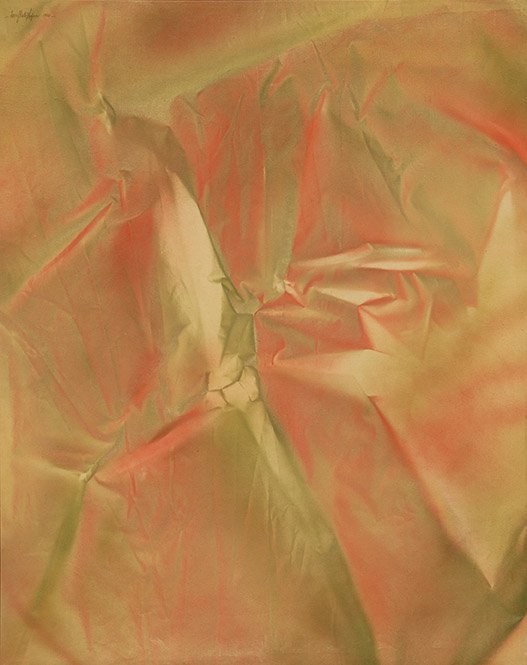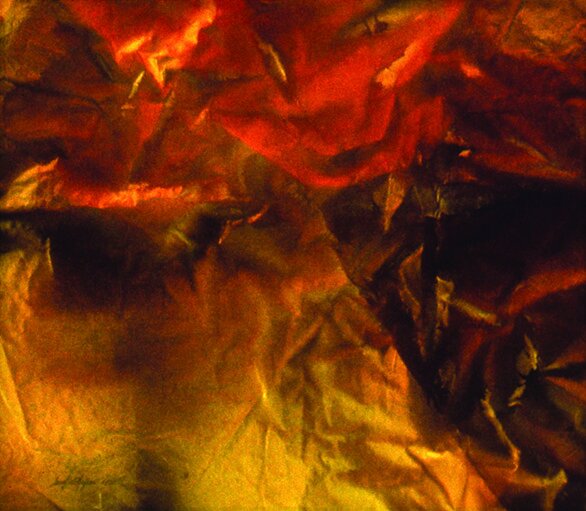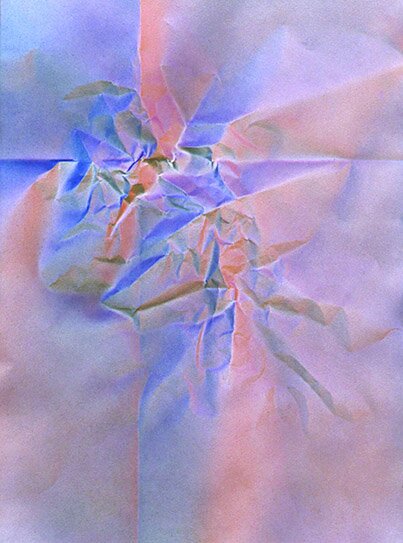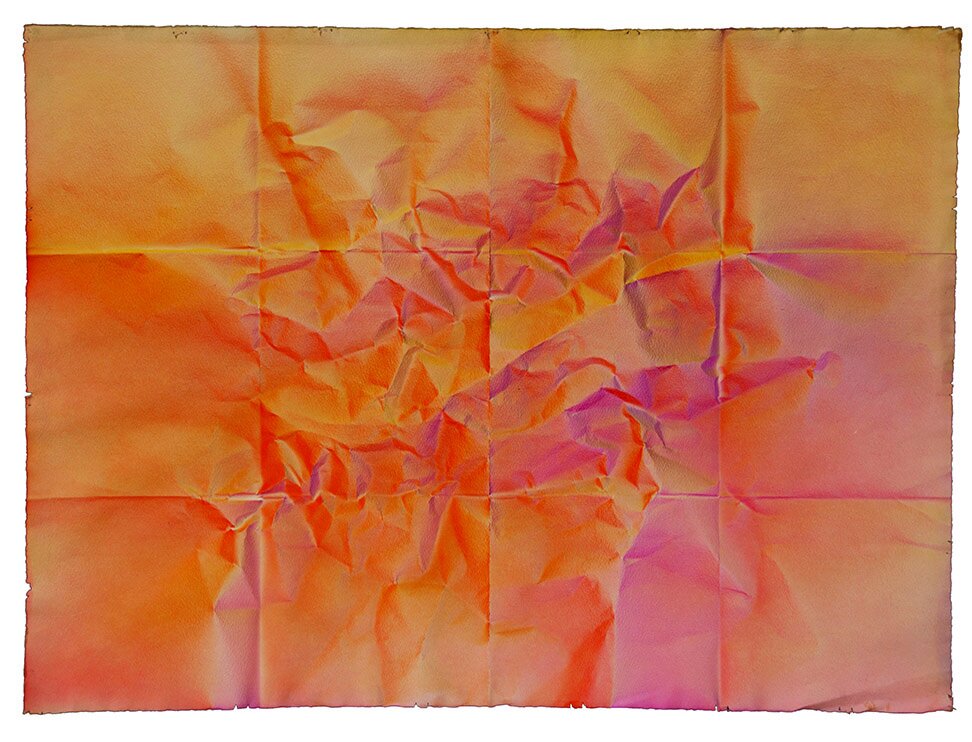Route 44 - A Journey, Chapter 3
Chapter 3
Eugene Bavinger was the primary painting professor at OU and had been so since 1947. He was a very soft-spoken man with a world of experience behind him. I met him as my professor for an advanced painting course. I quickly realized that there was a lot to learn from him. As I mentioned before Bavinger had been around a long time, thirty plus years. You would probably expect that he would be very set in his ways and a bit “old school.” You would be wrong, he was like a kid and extremely in tune with the latest art movements. He had been a pioneer in the use of acrylic paint and was constantly researching the chemistry of acrylic paint additives. I mentioned earlier that OU pushed you into larger and grander work; Bavinger was a key to making this affordable. He set up an Art Department store for painting supplies. Through this store, the Department would buy bulk 100-foot rolls of raw canvas in 72-inch widths. The students could purchase the canvas by the yard at a fraction of the retail cost. In addition to the canvas, the school would purchase fifty-five gallon drums of polymer medium directly from the manufacturer and sell to the students in gallon quantities. In class we learned the craft of making our own stretcher frames and how to convert inexpensive house paint into museum quality gesso. We also learned how to use the polymer medium and use it as a binder to add inexpensive tinting colors to make our own paint. All of this was done to encourage students to produce large, institutional size paintings because that was the current trend in most of the contemporary art movements of the time. OU and Gene Bavinger were very trend conscious. What ever was happening or even being experimented with in New York City was also being explored at OU. Gene was driven in the classroom and in his own personal work by trends and technology. The better I got to know him the more I understood this. At this particular time, the late sixties and early seventies, one of the hottest trends was in large atmospheric abstract paintings sometimes called “Color Field” or “Lyrical Abstractions.” These paintings were a huge visual change from the dynamic and energetic paintings produced by the “Abstract Impressionist.” They were more about light and space. They had a lyrical almost romantic feel to them. This movement certainly had roots in Abstract Expressionism with artists like Mark Rothko, Helen Frankenthaler and Jules Olitski. All three approached their paintings in very different paint application methods but managed to achieve a similar visual appeal. Rothko used traditional oil paint, Frankenthaler used thinly applied transparent stains and Olitski used commercial spray painting equipment. As I mentioned earlier, I was using canned spray paint as a method of applying color to large drawings and this led to acquiring an air brush in an effort to control the application, so the jump to larger spray equipment was a natural progression which was fueled by Gene Bavinger. Gene’s work at that time was visually similar to Olitski, very large lyrical abstractions that the viewer could literally get lost in the spacial illusion. I began the same way, playing (I want to emphasize the word play, much of what I was doing was experimentation) with the spray to create atmospheric backgrounds that I could draw with paint on top. This experimentation along with my observation of Bavinger’s personal work led me to a natural phenomenon directly related to the spray application. I think anyone that has experimented in spray paint application has witnessed this phenomenon at some point. The phenomenon that I am referring to is commonly called the “Wrinkle Technique.” The technique is simple, spray color on a wrinkled material, i.e. paper or canvas, stretch the material flat and the illusion of the wrinkle remains. I had witnessed this technique earlier in one of Bavinger’s paintings. It was a very small and insignificant part of the concept of the painting but very interesting, so when I discovered it myself, I immediately started working with it. The first few paintings were simple wrinkle illusions sprayed in different colors from different directions. I had some initial success outside the classroom and school. I entered a highly respected state competition sponsored by Philbrook Museum in Tulsa, Oklahoma, and won a purchase award. Another very nice thing about OU at that time was they had a nice visiting artist program and because it was the largest art program in the state there were always professional artists and professors from other schools dropping in unannounced. During this short period of time we had one “famous” artist (Paul Jenkins) and also two professors from other Universities (Bob Russell from Pittsburg, Kansas, and Bill Wyman from the University of Texas) drop in. They all seemed impressed with the wrinkle technique and were very encouraging. This outside encouragement along with input from Bavinger led me to push beyond the natural phenomenon of the technique and incorporate it with bigger and better concepts. I worked with this technique for about two years trying to make the visual aspect of the technique secondary to the overall concepts of light and space. I don’t think I ever really did that because the natural phenomenon was so powerful visually. Darn it, they were just too pretty! Yep, you guessed it, I was still stuck making big “pretty pictures.”
“Organic Forms” – Acrylic & Shaped Canvas – 60″x60″
“Organic Landscape” – Acrylic – 42″x60″
“Light and Space” – Acrylic – 32″x36″
“Light and Space 2″ – Acrylic – 48″x60”
About this time, 1970, OU hired a new painting professor, George Bogart. George came to help Gene with the growing painting program. He was an imposing figure; tall, thick dark hair and a big black mustache but he turned out to be a gentle patient man and one of the best teachers I have known. He immediately became another important mentor to my painting development. He was a great compliment to Gene’s technical, process driven approach to painting. George was a little more concept driven and both were prolific, passionate painters that practiced their craft every day. They both pushed me to work through problems and had a huge impact on me to develop a strong work ethic. I remember George telling me numerous times that, “A lot of good soldiers had to die before you can win the battle.” This was his way of telling me to keep working. I was now a senior in the program and realized that I should start thinking about what I was going to do when I graduated. I was majoring in Advertising Design and as I mentioned earlier very frustrated with my classes. It seemed no matter how hard I worked that I just wasn’t getting it. I now realize that my passion was elsewhere and it would take a different time and a different commitment, which I eventually achieved in about six years. I still retained a friendship with Jack Bryan at Cameron University. In a conversation with him, he mentioned that he was hopeful that in about a year he would be looking for a person to teach with him at Cameron. Wow, teach with Jack! How cool would that be? If I remember correctly, I think I stopped him mid-sentence and asked what it took to get that job. He replied, “Get your masters and come on down.” I now know that it would take a little more than that but I took that as a job offer, so I started thinking and actively looking at grad schools that offered a masters in art. I really hadn’t thought about teaching as a career and I sure didn’t know what it took to become one so I started doing a little research. I started asking my professors what kind of degrees they had and where they got their graduate degrees. I quickly found out there were different types of graduate degrees and even different types of masters degrees. I had become friends with some of the grad students at OU and most of them were in the MFA program. I learned that this was considered the highest graduate degree available in studio art and was basically the equivalent of a PhD in other academic areas. I found out that most MFA programs were around 60 hours and usually took at least two years to complete. Darn, this was about a year too long for my projected job offer at Cameron. I continued to look for grad programs that could be completed in one year. I found that in addition to the MFA there existed a MA program that consisted of about 30 hours and was geared more to secondary education teachers seeking to add to their teaching credentials. This degree was considered less professional but only took one year to complete. I also found there were 30-hour masters available in art history but I was definitely not interested in art history, again that came much later when I had to teach it. You know I had always heard that if you truly want to learn anything just teach it, it is definitely true. So, now I knew that I was probably looking for a 30-hour masters program that was heavy on studio work. In my limited research, I found that it was generally frowned on to attend the same school for your undergrad and graduate work. This made a lot of sense to me because you spend a minimum of four years studying with a group of professors then it’s time to get input from other sources to broaden the educational experience. Unfortunately for me, I was under a self-imposed deadline that greatly affected my decisions. My only choices in the state of Oklahoma at the time were to continue at OU and pursue a MA or possibly a MFA or to go to the University of Tulsa where they offered a MA. I could also look at schools outside the state but that didn’t seem possible with my tight deadline. At this point, I took a look at my major and decided that a studio degree would be better for graduate school application. I also thought the higher the GPA in my major area the better my chances would be for acceptance so, I switched my major from Advertising Design to Printmaking. I had enough credits to major in Ad Design, Painting or Printmaking but I had a 4.0 GPA in printmaking so I chose it. As I mentioned OU offered both a MFA and a MA and it appeared that the only difference in the academic requirements was the number of hours necessary for graduation. During my last semester in my undergraduate degree I started trying to calculate the number of hours and the minimum time it would take finish. At that time their MFA program consisted of 56 hours, 4 hours short of the more standard 60-hour programs. Their program consisted entirely of studio hours, no academic classes were required and this was very appealing. I was used to taking summer classes and I thought my one-year deadline could consist of two regular semesters and two summer semesters. After some quick calculations I realized that if I took 12 hours each summer semester and 16 hours each regular semester, voilà, that was the magic 56 hours. I was very young and naive but even I knew it would be a tremendous amount of work but the payoff seemed worth the effort. I made an appointment to talk with the Director of the Art School about the submission process and a few other questions I had about the differences in the MA and MFA programs. The Director at that time was Joe Hobbs. Joe was a tall lanky cowboy want-to-be sculptor. I never had him for any classes so I can’t speak to his ability to teach. He didn’t seem to actively make sculpture or art and the pieces that I had seen were a bit dated, but he was the Director of the program the entire time I was there and quite a few years after I left so he had a lot of administrative experience. When we met, I told him I was interested in applying for grad school. He was very encouraging and asked if I had specific questions. I asked him the difference in the two possible masters programs and he basically told me that the MFA was what I should be interested in. I then asked him if there was a mandatory amount of residency time necessary to fulfill the requirements for graduation and to obtain the degree. He looked at me with a puzzled look and said, “What do you mean?” I restated the question a little more directly and said, “If I can finish the required number of hours early can I graduate in less than two years.” He replied that there was no requirement on time, you must simply complete the required 56-hours and that was it. This was great news for me; he had just confirmed that it was possible to complete the MFA program in one year. I was set, all I had to do now was complete the application process, get accepted and start. This proved to be a bit more of a challenge than I thought. I completed the necessary paperwork during my last undergraduate semester. I finished my last semester and was awarded the Alexander Letzeiser silver metal. This was a surprise and a nice honor; it was the second highest honor that OU gave for graduating undergraduate art students.
“Wrinkle Study 1″ – Acrylic & Watercolor – 22″x30”
“Wrinkle Study 2″ – Acrylic & Watercolor – 22″x30”
“Wrinkle Study 3″ – Acrylic & Watercolor – 22″x30”
“Wrinkle Study 4″ – Acrylic & Watercolor – 22″x30”
“Ken and Irma’s Horse” – Acrylic – 60″x72″









